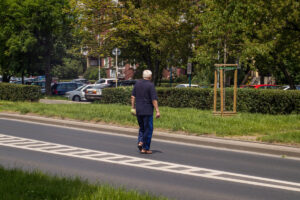Backroads may seem like a peaceful escape from the hustle and bustle of busy highways, but they often come with hidden dangers that can catch drivers off guard. These quiet, rural routes are riddled with challenges—sharp turns, unpredictable road conditions, and limited visibility—that make them surprisingly hazardous. Drivers often let their guard down, assuming they’ll encounter little to no traffic, but that false sense of security can lead to serious accidents. Understanding the risks and adopting safe driving practices can make all the difference in preventing life-altering crashes on these secluded roads.
With over six decades of experience handling personal injury cases, we understand how unexpected accidents on backroads can leave you facing uncertainty. At Byrd Davis Alden & Henrichson LLP, we’re dedicated to providing effective representation tailored to your unique circumstances. Recognized by Best Lawyers and Best Law Firms, we focus on helping you address the complexities of your case and move forward with confidence.
Traffic Accidents On Backroads
Many people realize the risks associated with driving in urban areas, on freeways and in other places that see a lot of traffic. However, we know that car accident risks are present in rural areas, including backroads that see very little traffic. In some cases, these roads are not even paved, but that does not mean that the possibility of a crash is not present. Moreover, while many of the accidents that do occur in these areas are relatively minor, some are very serious and result in debilitating injuries or the loss of life. In fact, fatal crashes are a significant concern on these backroads.
First of all, it is important to realize some of the reasons why backroads are especially dangerous in certain instances. For one, drivers do not always expect to encounter other vehicles while driving in a secluded area, so they drive too fast around turns or fail to pay attention to the road. Also, backroads often see large amounts of debris and road hazards, such as potholes, fallen trees, tree limbs, and so on. During certain times of the year, such as the winter, driving on a back road is very dangerous. Moreover, roads that are not paved often create concerns regarding visibility when a lot of dust is kicked up.
In addition, those hurt on backroads often face serious challenges. For example, when cell phone reception is poor and a back road is located in a very isolated area, some victims have difficulty getting the urgent help they need. These are just a few of the concerns associated with motor vehicle collisions that occur on backroads and we cover other topics related to recovering from a crash on our site.
Understanding Traffic Accidents
Traffic accidents can occur on any type of road, whether it’s a bustling highway, a quiet local road, or a secluded rural road. According to the National Highway Traffic Safety Administration (NHTSA), there were over 6 million police-reported crashes in the United States in 2020, resulting in more than 36,000 fatalities. These staggering numbers highlight the critical need to understand the causes and consequences of traffic accidents to enhance road safety and reduce the number of fatal accidents.
Fatal accidents are not confined to any single type of road. While highways and urban areas often come to mind when thinking about traffic accidents, rural roads are also significant contributors to these statistics. The unique challenges posed by rural roads, such as limited visibility, poor road conditions, and unexpected hazards, make them particularly dangerous. By gaining a deeper understanding of these factors, we can work towards implementing better safety measures and ultimately save lives.
What Makes Back Roads So Dangerous?
Traffic accidents can occur anywhere, but some roads are more prone to accidents than others. Backroads, in particular, pose a unique set of challenges for drivers. These rural roads often have limited visibility, poor road conditions, and a higher risk of accidents due to driver error, road hazards, and weather conditions. In this section, we will explore the characteristics of backroads and the factors that contribute to fatal accidents on these roads. Additionally, narrow two-lane roads have higher fatality rates compared to urban areas due to higher speeds, poorer visibility, and less law enforcement presence.
Characteristics of Rural Roads and Accident Risks
Backroads are typically rural roads with limited traffic and poor road conditions. These roads often see a high number of injury accidents due to their hazardous nature. These roads may not be paved, and the risk of a crash is still present. Drivers may drive too fast or fail to pay attention on backroads due to the expectation of encountering few other vehicles. Additionally, backroads often have large amounts of debris and road hazards, such as potholes, fallen trees, and tree limbs. Winter conditions can make driving on backroads extremely hazardous, and unpaved roads can create visibility concerns due to dust kicked up by vehicles.
Road Safety Comparison: Highways vs. Local Roads
When it comes to road safety, highways and local roads present different challenges and risks. Highways are generally designed with safety in mind, featuring limited access points, consistent speed limits, and physical barriers to separate opposing traffic. These design elements help to reduce the likelihood of head-on collisions and other severe accidents.
In contrast, local roads, including city streets and rural roads, tend to have a higher incidence of traffic accidents. Factors such as intersections, traffic lights, and pedestrian activity contribute to the increased risk. According to the NHTSA, in 2020, there were 1.49 fatalities per 100 million vehicle miles traveled on rural roads, compared to 0.91 fatalities per 100 million vehicle miles traveled on urban roads. This stark difference underscores the need for heightened awareness and caution when driving on local roads.
Rural roads, in particular, pose unique dangers due to their often poor conditions and the presence of unexpected hazards like wildlife or farm equipment. Additionally, the lack of traffic lights and other control measures can lead to higher speeds and more severe accidents. By understanding these differences, drivers can better prepare for the specific risks associated with each type of road and adopt safer driving practices accordingly.
Factors Contributing to Fatal Accidents on Backroads
Fatal accidents on backroads can be attributed to several factors, including driver error, road hazards, and weather conditions. Driver error, such as speeding or inattention, is a common cause of backroad accidents. Road hazards, including potholes, fallen trees, and tree limbs, can contribute to accidents. Weather conditions, such as winter weather, can increase the risk of accidents on backroads. Poor road conditions, including unpaved roads, can create visibility concerns and increase the risk of accidents. The Fatality Analysis Reporting System (FARS) plays a crucial role in analyzing data on these fatal accidents, helping to understand and address their causes.
Common Causes of Traffic Accidents on Backroads: Distracted Driving
Traffic deaths on backroads can be caused by a variety of factors, including driver error, road hazards, and weather conditions. Driver distractions, such as using a cell phone while driving, can increase the risk of accidents on back roads. Vehicle maintenance issues, such as worn-out tires or faulty brakes, can contribute to accidents on backroads. Driver fatigue can increase the risk of accidents on backroads, especially on long or monotonous drives. Additionally, impaired driving, such as driving under the influence of alcohol or drugs, can increase the risk of fatal accidents on back roads.
Safe Driving Practices for Backroads
To reduce the risk of accidents on backroads, drivers should practice safe driving habits, including adhering to the speed limit. This includes following traffic laws, such as speed limits, and being aware of road conditions and hazards. Drivers should also avoid distracted driving, such as using a cell phone while driving, and take regular breaks to avoid driver fatigue. Additionally, drivers should ensure their vehicle is properly maintained, including checking the tire pressure and brake function. By following these safe driving practices, drivers can reduce their risk of being involved in a fatal accident on a back road.
Protect Your Rights After a Backroad Accident
At Byrd Davis Alden & Henrichson LLP, we know that backroad accidents often leave victims in challenging situations, from physical injuries to legal complexities. As Austin’s oldest personal injury firm, we have a long history of providing effective and compassionate legal representation for those affected by serious traffic accidents. Our focus is on helping you secure fair compensation and addressing the unique circumstances that rural road crashes often present.
Whether it’s navigating insurance claims, dealing with liability issues, or understanding your legal options, we’re here to help. Our firm has been recognized by Best Lawyers and Best Law Firms, reflecting our commitment to client satisfaction and successful outcomes. Call us at (512) 454-3751 or visit our contact form to learn more about how we can assist you.


